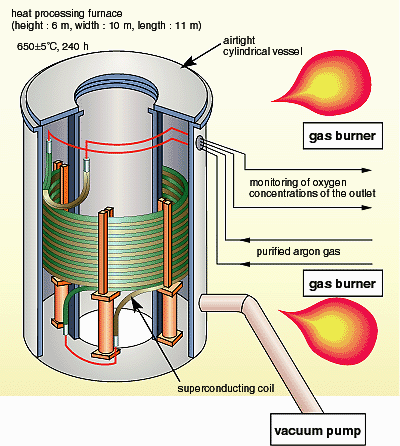| A superconducting magnet conductor used in a fusion reactor is
reinforced by a jacket to withstand high stress. Incoloy 908 is
one of the ferrite-nickel-chromium alloys and has the merits of
high strength at 4 K, and thermal expansion characteristics similar
to that of the superconducting conductor. However, in the case
of the usual thermal processing, the surface became more brittle
and cracks appear due to SAGBO. SAGBO occurs in the overlapping
of the condition of temperature higher than 823 K, stress larger
than 200 MPa and oxygen partial pressure higher than 1.33*10-2 Pa (0.14 ppm of the oxygen concentration in 1 atmospheric pressure).
The temperature of thermal processing necessary for NbTi conductors
is 823 K, and a residual stress larger than 200 MPa is inevitable
in the large coil winding jobs. Therefore, we have developed thermal
processing technology with a lower oxygen concentration (Fig.
2-21). As a result, the jacket is protected from cracks due to
SAGBO. A key issue is the removal of oils and absorbed gases from
the superconducting wires. Vacuum pumping and argon gas feeding
are carefully done in the temperature range without SAGBO. A criterion
for oxygen removal is obtained. Thermal processing for superconduction
is made after the oxygen concentration is low enough (less than
0.1 ppm). This is the first success of the large scale thermal
processing of metals with smaller oxygen concentrations. |
